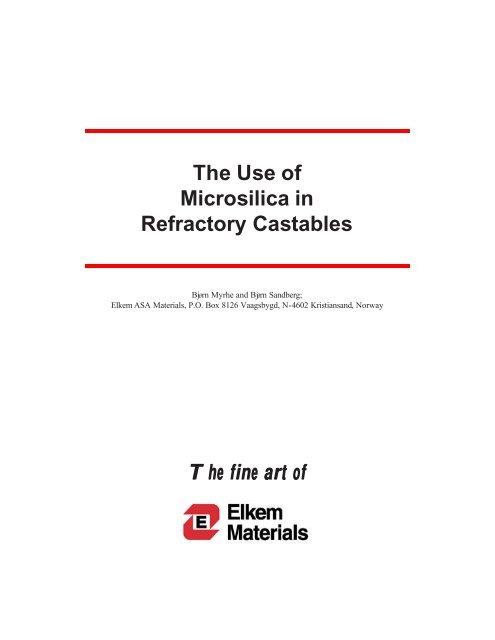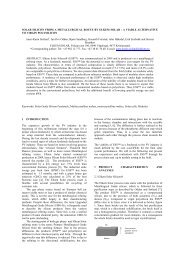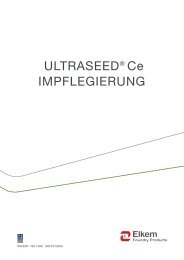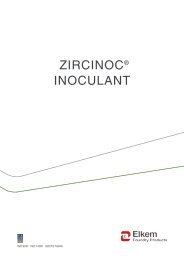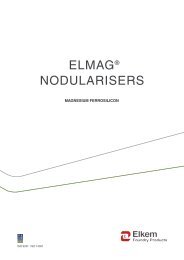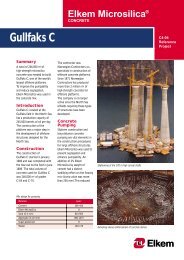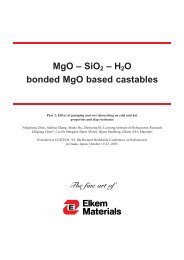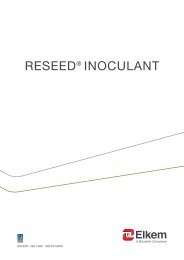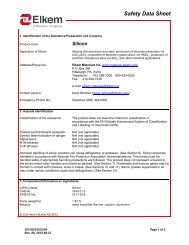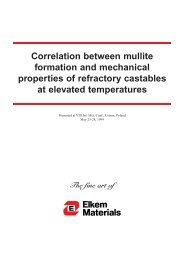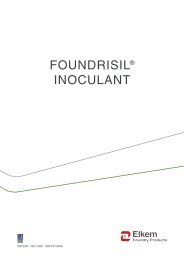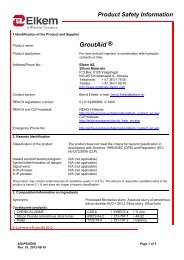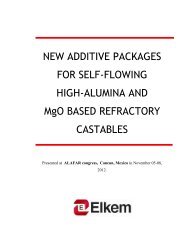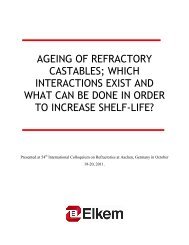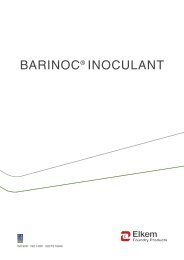The Use of Microsilica in Refractory Castables - Elkem
The Use of Microsilica in Refractory Castables - Elkem
The Use of Microsilica in Refractory Castables - Elkem
- No tags were found...
You also want an ePaper? Increase the reach of your titles
YUMPU automatically turns print PDFs into web optimized ePapers that Google loves.
<strong>The</strong> <strong>Use</strong> <strong>of</strong><strong>Microsilica</strong> <strong>in</strong><strong>Refractory</strong> <strong>Castables</strong>Bjørn Myrhe and Bjørn Sandberg;<strong>Elkem</strong> ASA Materials, P.O. Box 8126 Vaagsbygd, N-4602 Kristiansand, Norway<strong>The</strong> f<strong>in</strong>e art <strong>of</strong>
<strong>The</strong> <strong>Use</strong> <strong>of</strong> <strong>Microsilica</strong> <strong>in</strong> <strong>Refractory</strong> <strong>Castables</strong> 1Bjørn Myhre and Bjørn Sandberg; <strong>Elkem</strong> ASA Materials, P.O. Box 8126 Vaagsbygd, N-4602 Kristiansand, Norway.Abstract:<strong>The</strong> technology <strong>of</strong> prepar<strong>in</strong>g refractory castables is presented focus<strong>in</strong>g on the use <strong>of</strong>microsilica. Predictive flow control by the use <strong>of</strong> particle size distribution and set time controlat high temperatures are the ma<strong>in</strong> aspects <strong>of</strong> the refractory castable technology that ispresented <strong>in</strong> this paper.Introduction:<strong>The</strong> word microsilica has become generic for condensed silica fumes produced as byproducts<strong>of</strong> silicon and ferro-silicon production. <strong>Microsilica</strong>, also known as fumed silica,volatilized silica etc. normally orig<strong>in</strong>ates from the loss <strong>of</strong> SiO(g) which is an <strong>in</strong>termediatespecies <strong>in</strong> the production <strong>of</strong> silicon or ferrosilicon. It is difficult to state exactly when the term“microsilica” first appears, but <strong>in</strong> the early 1980´s <strong>Elkem</strong> registered <strong>Elkem</strong> <strong>Microsilica</strong> as atrade name for their fumed silica. It is probable that this is the orig<strong>in</strong> <strong>of</strong> the generic use <strong>of</strong>microsilica.<strong>The</strong> fumes:Silicon and ferrosilicon is produced <strong>in</strong> large electrical smelt<strong>in</strong>g furnaces by the reduction <strong>of</strong>quartz (SiO 2 ) with carbon. <strong>The</strong> raw materials are added from the top <strong>of</strong> furnace and form astack. <strong>The</strong> actual reduction to metal occurs <strong>in</strong> the bottom <strong>of</strong> the stack. Quarts and the otherraw materials are added as fairly large lumps which heats up on their voyage down the stack.<strong>The</strong> carbon may be added as a range <strong>of</strong> sources like coal, coke or charcoal; which one that isused is normally the result <strong>of</strong> economic and other considerations. Additional to the carbon,normally wood-chips are added to improve the texture <strong>of</strong> the stack.In the bottom <strong>of</strong> the furnace, where the temperature exceeds 2000°C the reduction takesplace through a series <strong>of</strong> <strong>in</strong>termediate reactions. One <strong>of</strong> these reactions produce the fairlyvolatile species silicon monoxide (SiO) that at temperatures above approximately 1800°C hasa vapor-pressure exceed<strong>in</strong>g 1 atmosphere. This gas which at that time is under pressure ejectsupwards <strong>in</strong> the stack, most gets trapped as it condenses, but some escapes and gets oxidizedwhen it comes <strong>in</strong> contact with the air above the stack. This is the orig<strong>in</strong> <strong>of</strong> microsilica. Ofcourse, as a lot <strong>of</strong> energy is used <strong>in</strong> the partial reduction <strong>of</strong> quartz to silicon monoxide, thisrepresents a loss for the metal producer. <strong>The</strong>refore most metal producers aims for a m<strong>in</strong>imum1 Most <strong>of</strong> the follow<strong>in</strong>g has been presented <strong>in</strong> earlier publications, but has been modified andadapted to the format and scope <strong>of</strong> the present paper. For a full list<strong>in</strong>g and copies <strong>of</strong> papers by thestaff at <strong>Elkem</strong> Materials, please contact one <strong>of</strong> the Authors at the address given.
silica loss. Nevertheless, some silicon monoxide will escape the stack and give microsilica.Typically 10-15% <strong>of</strong> the quarts ends up as microsilica under good furnace operation.It is not only silicon monoxide that leaves the furnace. Also a number <strong>of</strong> impurities arevolatilized. <strong>The</strong> source <strong>of</strong> which are the raw materials. Typical volatile impurities are oxides <strong>of</strong>alkalis. One <strong>of</strong> the more significant impurities is carbon <strong>of</strong> various sources. <strong>The</strong> carbon <strong>of</strong> themicrosilica is present as several forms: coke residues, silicon carbide, some tar relatedorganics and f<strong>in</strong>ally as carbon black.Above the top <strong>of</strong> the furnace, which essentially is an open construction, a hood is placed andwith the aid <strong>of</strong> huge fans, the volatiles are sucked <strong>of</strong>f and forced through a filter. Because <strong>of</strong>the suction and because the furnace is top-charged, also larger particles like wood-chips, cokeresidue and quarts dust are collected together with the fumes.Because <strong>of</strong> the above mentioned <strong>in</strong>troduction <strong>of</strong> foreign matter, microsilica has to bebeneficiated to give a high quality product. In Figure 1 microsilica production is schematicallyshown: <strong>The</strong> raw materials are fed <strong>in</strong>to the top <strong>of</strong> the furnace (A). <strong>The</strong> volatiles are sucked <strong>of</strong>fby a fan (D). To get rid <strong>of</strong> the coarse particles, the microsilica is treated <strong>in</strong> a pre-collector (C).<strong>The</strong> gas is then blown <strong>in</strong>to a baghouse filter and collected as “raw” microsilica. Furthertreatment may be given to achieve desired properties <strong>of</strong> the product. It should be mentionedthat other filter<strong>in</strong>g equipment than baghouse filters have been and are be<strong>in</strong>g used.Figure 1: Simplified flowsheet <strong>of</strong> the production <strong>of</strong> microsilica. (A) Furnace, (B)Chimney, (C) Pre-collection, (D) Fan, (E) Baghouse filter.What is microsilica?If we grab a handful <strong>of</strong> microsilica, the appearance is a f<strong>in</strong>e powder with variable color fromalmost black to slightly <strong>of</strong>f-white. <strong>The</strong>re is a strong correlation between the color and thecarbon content. This correlation is not straight forward though, s<strong>in</strong>ce the carbon may bepresent as coke residue or as silicon carbide additional to carbon black which is the impurity
<strong>in</strong>fluenc<strong>in</strong>g color. A closer exam<strong>in</strong>ation <strong>of</strong> the microsilica by electron microscopy reveals submicronspheres with a mean particle size <strong>of</strong> approximately 0.15 micron. <strong>The</strong> surface area, asdeterm<strong>in</strong>ed by nitrogen adsorption (BET), typically gives values around 20 m 2 /g which isequivalent to a spherical diameter <strong>of</strong> 0.14 micron, i.e. close to the results obta<strong>in</strong>ed by electronmicroscopy.Figure 2:Micrograph <strong>of</strong> a microsilica cluster show<strong>in</strong>g spherical appearance <strong>of</strong> the <strong>in</strong>dividualparticles.Chemically, microsilica consists <strong>of</strong> amorphous SiO 2with variable purity. Without go<strong>in</strong>g <strong>in</strong>todetail, it may be stated that there is a close relation between the furnace operation and thequality <strong>of</strong> the microsilica. Hence traditionally, the purity <strong>of</strong> the microsilica tends to be rathervariable, reflect<strong>in</strong>g the furnace operation at the time it was collected. As the metal normally isthe ma<strong>in</strong> product and microsilica the by-product, a variation <strong>in</strong> the performance <strong>of</strong> themicrosilica should thus be expected. This is true for all grades <strong>of</strong> microsilica except for <strong>Elkem</strong><strong>Microsilica</strong> grade 971U, 971D and 983U s<strong>in</strong>ce these are produced as ma<strong>in</strong> products with thesilicon metal as the by-product.A typical analysis <strong>of</strong> a high quality refractory grade microsilica is given <strong>in</strong> Table 1.
Table 1: Typical analysis[%] <strong>of</strong> a high quality refractory grade microsilica.Component SiO2Al2O3CaO Fe2O3MgO Na2O K2O C pH<strong>Microsilica</strong> 97.5 0.4 0.2 0.1 0.1 0.1 0.3 0.5 6.0<strong>The</strong> crystall<strong>in</strong>ity <strong>of</strong> microsilica is variable accord<strong>in</strong>g to source and beneficiation, but valesbelow 0.3 % by weight 1 have been reported. Unpublished work on recent microsilicaproduction (<strong>Elkem</strong> <strong>Microsilica</strong> 983U) did however not show any traces <strong>of</strong> crystall<strong>in</strong>ity.<strong>Microsilica</strong> consist <strong>of</strong> spheres with an average diameter <strong>of</strong> about 0.15 micron. <strong>The</strong>se spheresare the build<strong>in</strong>g units <strong>of</strong> primary aggregates that are a few spheres bonded together by materialbridges. 2 When the particle size distribution is analyzed <strong>in</strong> a laser diffraction equipment, evenwell dispersed samples will show a d 50<strong>of</strong> around 0.5 micron. Figure 3 shows a typical particlesize distribution <strong>of</strong> a well dispersed microsilica as measured by laser diffraction (Microtrack).Particle size distribution100.00<strong>Elkem</strong> <strong>Microsilica</strong>90.0080.0070.00Percentage pass60.0050.0040.0030.0020.0010.000.000.10 1.00 10.00 100.00 1000.00Particle size [micron]Figure 3: Typical particle size distribution <strong>of</strong> a well dispersed microsilica as measured bylaser diffraction.<strong>The</strong> distribution around 0.5 micron may be expla<strong>in</strong>ed by the primary aggregates. Imag<strong>in</strong>e three0.15 micron spheres that are l<strong>in</strong>early attached to each other. This will make up a rod likestructure <strong>of</strong> approximately 0.45 micron length. If this rod-like structure is dispersed <strong>in</strong> a liquidit sp<strong>in</strong>s around and may thus be registered as a sphere <strong>of</strong> diameter 0.45 micron. Generally, theprimary aggregates are <strong>of</strong> a three-dimensional nature consist<strong>in</strong>g <strong>of</strong> a higher number <strong>of</strong> primaryspheres. Under any circumstances, the measured particle size distribution <strong>of</strong> microsilica mustnot uncritically be applied. Numerous results from the laboratory have shown that <strong>in</strong> castablesthe effect <strong>of</strong> microsilica is equivalent to a powder with d 50 around 0.15 micron and with a wideparticle size distribution.<strong>The</strong> past:
Előterjesztések az éves rendes közgyűlés számáraAz igénybe vett szolgáltatások értéke 681,7 millió for<strong>in</strong>tot képviselt, mely 81 millió for<strong>in</strong>ttal, 13,5%-kalemelkedett az előző évhez képest. A nagyarányú növekedést több tényező együttes növekedésebefolyásolta. A legnagyobb arányú növekedést, közel 28 millió for<strong>in</strong>ttal a devizában megállapított bérletidíjak árfolyam-differenciából fakadó emelkedése, és a raktárterület 580 m 2 -es bérleti díj növekményeokozta. Az előző időszakhoz képest jelentősen, m<strong>in</strong>tegy 19 millió for<strong>in</strong>ttal magasabb értékű munkaerőkölcsönzés valósult meg, míg a market<strong>in</strong>g költségek 15 millió for<strong>in</strong>ttal növekedtek. Az idei évben az egyébigénybevett szolgáltatások köre bővült a saját kiadású könyvekkel kapcsolatos szolgáltatásokkal, amelyközel 15 millió for<strong>in</strong>tos költségnövekményt okozott.A személyi jellegű ráfordítások 385,3 millió for<strong>in</strong>tot tettek ki, amely szerény mértékű, 1,5%-os mérséklődéstmutatva, 5,8 millió for<strong>in</strong>ttal kevesebb az egy évvel ezelőtti értéknél.Az egyéb ráfordítások összege 79,8 millió for<strong>in</strong>t volt, ezen belül 25 millió for<strong>in</strong>t terhet jelentett az adottidőszakra elszámolt iparűzési adó.A 2012-es év során a Társaság csaknem 152 millió for<strong>in</strong>t értékcsökkenést számolt el, ami 9,4 millió for<strong>in</strong>ttal,6,6%-kal magasabb az egy évvel korábbi értéknél.6. Egyéb eredménytételek alakulásaA Shopl<strong>in</strong>e-webáruház Nyrt. pénzügyi műveletekből származó bevétele 30,6 millió for<strong>in</strong>tot tett ki 2012-ben,ezen belül a kapott kamatok nagysága 23,5 millió for<strong>in</strong>t volt, míg a pénzügyi műveletek egyéb bevétele<strong>in</strong>ek7,1 millió for<strong>in</strong>tos összege árfolyameredmény. A Társaság pénzügyi műveletekből adódó ráfordítása89,6 millió for<strong>in</strong>t volt. A ráfordításokból a (banki hitelek, líz<strong>in</strong>gek után) fizetett kamatok nagysága 9,4 milliófor<strong>in</strong>tot tett ki, míg az árfolyam különbözet összege 79,8 millió for<strong>in</strong>t volt.A Társaság adózás előtti eredménye 39,9 millió for<strong>in</strong>t veszteség lett. Az időszakra vonatkozóan a Shopl<strong>in</strong>ewebáruházNyrt. 2,9 millió for<strong>in</strong>t adófizetési kötelezettséget mutatott ki, így az adózott eredménye42,8 millió for<strong>in</strong>t veszteség volt 2012-ben.7. Készletek alakulásaA Shopl<strong>in</strong>e-webáruház Nyrt. tevékenységéből adódóan jelentős raktárállománnyal működik, melyen belülrendelkezik saját tulajdonú, úgynevezett fix raktárkészlettel és a kiadók által kihelyezett bizományosraktárkészlettel is. A saját készleteit a Társaság igyekszik lehetőségeihez mérten optimális sz<strong>in</strong>ten tartani. Azennek érdekében az év elején megkezdett optimalizációs folyamat az időszak során folytatódott.2012. december 31-én a készletek értéke 230,5 millió for<strong>in</strong>tot tett ki, amely 86,4 millió for<strong>in</strong>ttal, 60%-kalmagasabb az egy évvel korábbi állománynál. A készletérték nagyarányú növekedését elsősorban az újüzletágak gyorsan bővülő választéka és – a negyedik negyedévben el<strong>in</strong>dult kiadói tevékenységhezkapcsolódóan – a saját termelésű készletek állománya okozta.8. Egyéb mérleg tételek alakulásaA Shopl<strong>in</strong>e-webáruház Nyrt. 2012. december 31-i mérlegfőösszege 2.535,7 millió for<strong>in</strong>t volt, amely csaknem27 millió for<strong>in</strong>t (1,1%) növekedést mutat az előző év végéhez viszonyítva.A befektetett eszközökön belül az immateriális javak értéke 69,7 millió for<strong>in</strong>ttal (25,3%-kal) alacsonyabb azelőző évi értéknél, míg a tárgyi eszközök értéke 7,7 millió for<strong>in</strong>ttal, 8,1%-kal csökkent egy év alatt.A befektetett pénzügyi eszközökön belül, a tartós részesedés értéke kapcsolt vállalkozásban 10 milliófor<strong>in</strong>tra bővült. A változás oka a tartós részesedésekre (eKönyv Magyarország Kft.) 2011-ben elszámoltértékvesztés visszaírása volt, tek<strong>in</strong>tettel a Társaság menedzsmentjének álláspontjára, mely szer<strong>in</strong>t azA Shopl<strong>in</strong>e-webáruház Nyrt. Igazgatóságának 2012. évi beszámolója 6/11
It was the well-known patents <strong>of</strong> Prost 9 and Lafarge 10 that presented the guidel<strong>in</strong>es for thedevelopment <strong>of</strong> modern low-cement castables. It is reasonable to believe that a major part <strong>of</strong>the castables conta<strong>in</strong><strong>in</strong>g microsilica be<strong>in</strong>g produced today are based on these patents.Bond systems - castables:A "standard" bond system <strong>in</strong> low-cement castables is consist<strong>in</strong>g <strong>of</strong> calcium - alum<strong>in</strong>ate cement,microsilica, a f<strong>in</strong>ely milled calc<strong>in</strong>ed alum<strong>in</strong>a and a dispersant. A large variety <strong>of</strong>modifications/extensions <strong>of</strong> this basic system is possible.As microsilica normally are the f<strong>in</strong>est particles <strong>in</strong> the system, hav<strong>in</strong>g a specific surface area <strong>of</strong>approx. 20m2/gram, surface properties and impurities are important <strong>in</strong> determ<strong>in</strong><strong>in</strong>g the cast<strong>in</strong>gand sett<strong>in</strong>g properties <strong>of</strong> a castable. <strong>The</strong> microsilica may contribute more than 50% <strong>of</strong> the totalparticles surface area <strong>in</strong> certa<strong>in</strong> mixes.<strong>Microsilica</strong> normally has a negative surface charge <strong>of</strong> approximately -20 to -30 mV <strong>in</strong> aqueoussystems, the zero po<strong>in</strong>t <strong>of</strong> charge be<strong>in</strong>g around pH 2-3. Cement and alum<strong>in</strong>a may show aslightly positive charge depend<strong>in</strong>g on pH. Hence, a slurry mix <strong>of</strong> these components will not bestable, but prone to coagulation. Additional, and more important <strong>in</strong> this context is that even t<strong>in</strong>yamounts <strong>of</strong> Ca 2+ ions <strong>in</strong> a silica slurry causes coagulation. <strong>The</strong> cement is here the obvioussource <strong>of</strong> calcium. <strong>The</strong> coagulation is caused by the calcium be<strong>in</strong>g absorbed on the silicasurface. <strong>The</strong> coagulation products are volum<strong>in</strong>ous and rather stiff and the result is a castablethat at the best could be a fairly hardly placed vibratable or commonly more like a ramm<strong>in</strong>gmix unless significantly more water is added. Thus to prevent this coagulation, the calcium ionshas to be prevented from absorb<strong>in</strong>g on the silica surface. This may either be done by hav<strong>in</strong>g apH below 5, but as this may affect sett<strong>in</strong>g, addition <strong>of</strong> a proper amount <strong>of</strong> a polyelectrolyte ora surface active agent is the common stratagem. <strong>The</strong> surface active agent, normally termeddeflocculant (<strong>in</strong> Portland cement based systems termed plasticiser or superplasticiser), isbelieved to absorb to surfaces thus h<strong>in</strong>der<strong>in</strong>g the absorption <strong>of</strong> calcium but also creates anequal, normally negative charge <strong>of</strong> the particles <strong>of</strong> the bond system. As the particles then willrepel each other, cast<strong>in</strong>g can take place at reduced water additions. Deflocculants commonlyused are phosphates, e.g. sodium hexametaphosphate (Calgon) at approximately 0.2 wt%addition level, and polyacrylates (Darvan 811D, 0.05 wt%).<strong>The</strong> deflocculat<strong>in</strong>g mechanism may vary. Results <strong>in</strong>dicate that the phosphates adheres to themicrosilica surface, more or less "clean<strong>in</strong>g" the surface from other impurities, whereas somehigh molecular weight organic molecules might "curl up" between the particles, keep<strong>in</strong>g themapart. When apply<strong>in</strong>g phosphates <strong>in</strong> a castable, one may observe a black surface film on thecastable be<strong>in</strong>g formed dur<strong>in</strong>g vibration. This seems to be carbon-conta<strong>in</strong><strong>in</strong>g impurities froma.o. the microsilica surface. This effect may not be observed with other deflocculants.<strong>The</strong> effect <strong>of</strong> microsilica <strong>in</strong> a fresh castable is at least dual. Once properly dispersed, oneimportant property is to reduce the cement content <strong>of</strong> refractory castables due to the smallparticle size <strong>of</strong> microsilica. Accord<strong>in</strong>g to the patents by Prost and Lafarge, the cement content<strong>of</strong> refractory castables may be reduced to approximately 1% by the use <strong>of</strong> carefully gradedparticles all the way down to sub-micron sizes. <strong>The</strong> use <strong>of</strong> superf<strong>in</strong>e particles is based on the
assumption that <strong>in</strong> a castable with a classical gra<strong>in</strong> size distribution, the density is limited by<strong>in</strong>tergranular voids that are filled with excess water dur<strong>in</strong>g <strong>in</strong>stallation. <strong>The</strong>se voids may befilled by successively f<strong>in</strong>er particles, thus replac<strong>in</strong>g the water. <strong>The</strong> use <strong>of</strong> these pr<strong>in</strong>ciples haslead to refractory castables with very low water demand, and consequently high compactness.<strong>Use</strong> <strong>of</strong> microsilica may reduce the open porosity from about 20-30% to 8-16% after fir<strong>in</strong>g at1000°C, and the drop <strong>in</strong> mechanical strength that is experienced <strong>in</strong> conventional castables at<strong>in</strong>termediate temperatures alters to a steady <strong>in</strong>crease. <strong>The</strong> beneficial effects <strong>of</strong> microsilica <strong>in</strong>castables are well established both <strong>in</strong> theory and practice. Dense pack<strong>in</strong>g is achieved, and thecement content may be drastically reduced. Cement contents result<strong>in</strong>g <strong>in</strong> lime contents <strong>of</strong> 2.5-0.2% is now readily available. Lime contents from cement <strong>of</strong> 2.5-1% is now classified as lowcementcastables while lime contents <strong>of</strong> 1-0.2% is classified as ultralow-cement castables.Act<strong>in</strong>g as a filler is not the only effect <strong>of</strong> microsilica <strong>in</strong> refractory castables. It has been shown<strong>in</strong> studie s <strong>of</strong> cement pastes with microsilica that a certa<strong>in</strong> fraction <strong>of</strong> the microsilica reacts withthe cement and water to form so-called CASH phases <strong>in</strong> addition to the CAH and AH phasesnormally found <strong>in</strong> hydrated cement. <strong>The</strong> CASH phases are <strong>of</strong> zeolithic nature and the amount<strong>of</strong> these hydration products are dependent on the quality (purity) <strong>of</strong> the microsilica. 11 <strong>The</strong>addition <strong>of</strong> microsilica was also found to alter the pore-size distribution towards f<strong>in</strong>er pores, aneffect that is probably more <strong>of</strong> physical than chemical nature. Dur<strong>in</strong>g heat<strong>in</strong>g, the CASHphases convert to CAS 2and (probably) to cristobalite or quartz. Excess microsilica alsocrystallizes.It should be stressed that successful use <strong>of</strong> both low, and <strong>in</strong> particular, ultralow-cementcastables is dependent on proper use and <strong>in</strong>stallation. Due to their high content <strong>of</strong> f<strong>in</strong>es, thesecastables are usually thixotropic, and requires vibration for placement. <strong>The</strong> recommendedwater addition should be strictly followed as the quality <strong>of</strong> the f<strong>in</strong>al refractory is verydependent on proper <strong>in</strong>stallation. <strong>The</strong> water should be potable. One common problem foundon site is the lack <strong>of</strong> suitable mixers. This results <strong>of</strong>ten <strong>in</strong> too much water added, a practice thatis detrimental to the f<strong>in</strong>al properties <strong>of</strong> the castable. As an example, 12 a fireclay based lowcementcastable with 4-5% water may develop a cold crush<strong>in</strong>g strength <strong>of</strong> 110 MPa. Thisvalue may drop to 80 MPa with 6% water, and around 50 MPa with 7% water. In addition,the set-time may be negatively <strong>in</strong>fluenced and the f<strong>in</strong>al product will become more porous.Particle Pack<strong>in</strong>g:<strong>The</strong> use <strong>of</strong> particle size distribution (PSD) as tool <strong>in</strong> the construction <strong>of</strong> refractory castableshas the recent few years become more common. Particle size distributions as such have beenemployed for a number <strong>of</strong> years though, but on a rather limited scale i. e. for the coarser end<strong>of</strong> the distribution. New methods <strong>of</strong> particle size measurements have made it possible toanalyze the sub-sieve fractions to a fuller extent, and it has been found that these are at least, ifnot more, important as the coarse end <strong>of</strong> the distribution. 13Often, the aim <strong>of</strong> refractory producers is to get as dense refractory structures as possible. Inthe case <strong>of</strong> castables, as flow is required, there has normally been a compromise betweendensity and ease <strong>of</strong> placement. S<strong>in</strong>ce the added water transforms to porosity upon heat<strong>in</strong>g,m<strong>in</strong>imiz<strong>in</strong>g the water addition has been one <strong>of</strong> the major tasks <strong>in</strong> the development <strong>of</strong> castabletechnology. <strong>The</strong>oretically, one would expect that if the <strong>in</strong>dividual particles <strong>of</strong> the castable
packed perfectly, i. e. to 100% density, then the water addition should be at the m<strong>in</strong>imum. Acomb<strong>in</strong>ation <strong>of</strong> 100% pack<strong>in</strong>g density together with flowability is however ruled out primarilybecause flow is the effect <strong>of</strong> particles be<strong>in</strong>g able to move relative to each other. 100% pack<strong>in</strong>gdensity gives no room for movement and is thus contradictory to flow.Pack<strong>in</strong>g pr<strong>in</strong>ciples:Even though 100% pack<strong>in</strong>g density is not obta<strong>in</strong>able, control <strong>of</strong> the particle size distribution <strong>of</strong>a castable is <strong>of</strong> vital importance. Ma<strong>in</strong>ly for two reasons:i) <strong>The</strong> particle size distribution may decide whether the castable is <strong>of</strong> a vibratable or a selfflow<strong>in</strong>g type. 14 It is possible to design a castable to be either by us<strong>in</strong>g PSD analyses.ii) Although 100% pack<strong>in</strong>g density is contradictory to flow, a solids structure with optimumpack<strong>in</strong>g theoretically requires less water for placement than castables with imperfect pack<strong>in</strong>g.To prepare a powder mix that has optimum pack<strong>in</strong>g, one must first <strong>of</strong> all know what the PSDshould look like, and secondly what is the PSD <strong>of</strong> your mix? <strong>The</strong> first criterion is given by apack<strong>in</strong>g model. S<strong>in</strong>ce castables consist <strong>of</strong> mixtures <strong>of</strong> powders with cont<strong>in</strong>uos distributions,one must look for models deal<strong>in</strong>g with such. Although a number <strong>of</strong> pack<strong>in</strong>g models have beenpresented over the last century, there are only a few that have been used to any extent <strong>in</strong> thepreparation <strong>of</strong> refractory castables. <strong>The</strong> models <strong>of</strong> Furnas and Anderegg 15,16 andAndreassen 17 may stand as the classical examples. <strong>The</strong> model <strong>of</strong> Furnas and Anderegg ishowever difficult and cumbersome to use. <strong>The</strong> model <strong>of</strong> Andreassen is much simpler but has,to some extent undeservedly, been criticized because <strong>of</strong> its semi-empirical nature. One<strong>in</strong>terest<strong>in</strong>g aspect <strong>of</strong> the Andreassen model is that it is not requir<strong>in</strong>g any shape factor. It onlyrequires the different particles to be <strong>of</strong> similar shape. <strong>The</strong> ma<strong>in</strong> objections that has been raisedaga<strong>in</strong>st the Andreassen equation has been that the model supposes <strong>in</strong>f<strong>in</strong>itely small particles. Toovercome this problem, D<strong>in</strong>ger and Funk, by comb<strong>in</strong><strong>in</strong>g the Andreassen and the Furnasdistribution, made a modified Andreassen distribution <strong>in</strong> which a m<strong>in</strong>imum particle size was<strong>in</strong>corporated. 18 <strong>The</strong> resultant model is much easier to use than the one given by Furnas, and isfrequently called the "modified Andreassen" or the "D<strong>in</strong>ger and Funk" equation. <strong>The</strong> shape <strong>of</strong>the models, when plotted <strong>in</strong> a logaritmic diagram is a straight l<strong>in</strong>e for the Andreassendistribution and l<strong>in</strong>es with downwards curvature for the modified Andreassen and the Furnasdistribution. As a matter <strong>of</strong> fact, for a given set <strong>of</strong> parameters, the modified Andreassen andthe Furnas distribution give identical distributions. Below is given the models as proposed byAndreassen and D<strong>in</strong>ger and Funk (modified Andreassen):Andreassen:CPFT = (d/D) q .100Modified Andreassen:CPFT = [(d q -dm q )/(D q -dm q )] . 100CPFT: Cumulative Percent F<strong>in</strong>er Thand: Particle size
dm: M<strong>in</strong>imum particle size <strong>of</strong> the distributionD: maximum particle sizeq: distribution coefficient (q-value)One important aspect when deal<strong>in</strong>g with particle size distributions is that they are always basedon volumes. So for mixtures <strong>of</strong> powders with different densities, the amounts always has to betransformed to volumes <strong>in</strong> order to give volume percents. <strong>The</strong> parameters <strong>of</strong> the Andreassenand the modified Andreassen equation are the same i.e. the q-value is identical for both. Oneimportant result presented by D<strong>in</strong>ger and Funk was the <strong>in</strong>fluence <strong>of</strong> the q-value on pack<strong>in</strong>g.By computer simulations they found that if the q-value was 0.37 or lower, then 100% pack<strong>in</strong>gdensity was possible for <strong>in</strong>f<strong>in</strong>ite distributions, while for q-values above 0.37, there is alwaysporosity 19 . So, to get dense pack<strong>in</strong>g, the q-value should not exceed 0.37. As a curiosity it maybe mentioned that Andreassen, <strong>in</strong> his orig<strong>in</strong>al paper from 1930 <strong>in</strong>dicated the q-value to havean optimum value somewhere between 1/3 and 1/2.<strong>The</strong> Furnas distribution has been much used <strong>in</strong> refractories. A common experience when us<strong>in</strong>gthis distribution on castables has been that flow is improved by add<strong>in</strong>g more <strong>of</strong> the f<strong>in</strong>estfraction. By add<strong>in</strong>g more <strong>of</strong> the superf<strong>in</strong>es, the downward curvature <strong>of</strong> the distribution isstraightened. Or put slightly different, add<strong>in</strong>g more superf<strong>in</strong>es changes the distribution from aFurnas type towards an Andreassen type. Thus <strong>in</strong> spite <strong>of</strong> the imperfections <strong>of</strong> the Andreassendistribution, it has been found that it works better for refractory castables than those <strong>of</strong> theFurnas type 20 on systems with microsilica.Results from systems based on the Andreassen equation have <strong>in</strong>dicated that <strong>in</strong> order to getgood flow for castables, the q-value should not exceed approximately 0.3. Model systemsbased on fused alum<strong>in</strong>a have shown13 that by manipulat<strong>in</strong>g the q-value <strong>in</strong> the range 0.2 to 0.3,one may <strong>in</strong>fluence the flow pattern <strong>of</strong> the castables. If relatively high q-values are used (i.e.close to 0.3) then the castables are vibratables, for lower q-values (
powders there are a few precautions to consider though. <strong>The</strong> powder must be properlydispersed, and premature settl<strong>in</strong>g must be prevented if suspensions are used. For milledfractions <strong>of</strong> relatively heavy material like corundum it may be necessary to wet-sieve andthen analyze the f<strong>in</strong>est fraction <strong>in</strong> the particle size analyzer. Afterwards the sieved and theanalyzed data may be comb<strong>in</strong>ed to make the PSD <strong>of</strong> the milled corundum.2) Gra<strong>in</strong> density <strong>of</strong> the fraction. For f<strong>in</strong>ely milled material this is normally close to the specificgravity. For materials with closed porosity, the gra<strong>in</strong> density has to be determ<strong>in</strong>ed.When the PSD and the density <strong>of</strong> the different components are available, the first step is tocalculate the volume <strong>of</strong> each component (Vi) by the use <strong>of</strong> the amount Ni and the density ρi.Because the amount is converted to absolute volume, it may be entered either as percent or asweight. <strong>The</strong> weight unit should <strong>of</strong> course comply with the unit used <strong>in</strong> the density.Vi= Ni / ρi<strong>The</strong> volume fraction Xi may then be calculated:Xi= V i / Σ n i=1 V i<strong>The</strong>n for each component, multiply the CPFT for each size with the correspond<strong>in</strong>g volumefraction. This gives the contribution from each size class <strong>of</strong> component “i” to the PSD <strong>of</strong> theentire mix.CPFT mix,i = X i. CPFTi<strong>The</strong>n add the CPFT for each size class for all components to give the composite CPFT for thegiven size class:CPFT mix =Σ n i=1 CPFT mix,iBy now, each size class should have a correspond<strong>in</strong>g composite CPFT, CPFTmix, thatconta<strong>in</strong>s elements from all components. If the calculations are done correctly, then the list<strong>in</strong>gshould start at 100 for the largest sizes, and end at 0. A plot <strong>of</strong> the composite CPFT aga<strong>in</strong>st
the size classes should also give a curve without any dips. If dips occur, then it is likely thateither the calculation is wrong or that one or several <strong>of</strong> the <strong>in</strong>dividual PSD conta<strong>in</strong> errorscaus<strong>in</strong>g dips.In Figure 4, such a composite PSD is given together with the PSDs <strong>of</strong> the <strong>in</strong>dividualcomponents. <strong>The</strong> composite PSD is here designed to match an Andreassen distribution with aq-value <strong>of</strong> 0.26 and D=4000 micron. <strong>The</strong> Andreassen distribution is <strong>in</strong>dicated as the straightl<strong>in</strong>e touch<strong>in</strong>g the composite PSD.Figure 4: PSD; the <strong>in</strong>dividual PSDs that have been used <strong>in</strong> the construction <strong>of</strong> acomposite PSD to match an Andreassen distribution with a q-value <strong>of</strong> 0.26 and D=4000micron.<strong>The</strong> calculations are not advanced, but numerous. It is therefore an ideal task for spread-sheetcalculations. Composite particle size distributions makes it simpler to use overlapp<strong>in</strong>g andopen fractions <strong>in</strong> the manufacture <strong>of</strong> refractory castables. This way the number <strong>of</strong> components<strong>in</strong> a refractory mix may be reduced. E.g. it is possible to manufacture a refractory castableconsist<strong>in</strong>g <strong>of</strong> 4-5 components. Other areas <strong>of</strong> use is <strong>in</strong> research and development, either tomake castables accord<strong>in</strong>g to some predeterm<strong>in</strong>ed PSD or to check and/or repeat someparticularly successful castable with other raw materials. If a milled fraction for some reasonhas changed characteristics, it is relatively simple to adjust the recipe so that the PSD isma<strong>in</strong>ta<strong>in</strong>ed. This way a significant amount <strong>of</strong> labor may be saved.About the choice <strong>of</strong> model:<strong>The</strong> use <strong>of</strong> the Andreassen distribution is based on results from the laboratory us<strong>in</strong>g particlesize distributions as shown <strong>in</strong> Figure 4. What regards the <strong>in</strong>dividual particle size distributions <strong>of</strong>the components these are probably close to correct, except for that <strong>of</strong> the microsilica. Forreasons mentioned under “What is microsilica” it may be doubtful if the PSD that is obta<strong>in</strong>edby laser diffraction is relevant <strong>in</strong> this context. However as it is difficult to establish an “effective
PSD” by analytical methods, it has been chosen to use the PSD as given by laser diffraction.As long as microsilica is the f<strong>in</strong>est fraction that is used it does not <strong>in</strong>fluence too much on thecomposite PSD. <strong>The</strong> shape <strong>of</strong> the PSD <strong>of</strong> microsilica is reflected <strong>in</strong> the composite PSD andsuggests that the Andreassen equation may be applicable if the deviation at the very low sizeclasses is ignored. It may well be so that the modified Andreassen equation (D<strong>in</strong>ger and Funk)is the correct distribution to aim for, if one establishes a sufficiently small d m. However as thetwo distributions are close to equal for the bulk <strong>of</strong> the distribution and because the deviationprobably is with<strong>in</strong> the “unmeasurable” range below 1 micron, practical considerations makesthe Andreassen equation the preferred choice.About superf<strong>in</strong>e powders:It has been shown that if the Andreassen distribution is applied, then it is possible to get 100%pack<strong>in</strong>g density for an <strong>in</strong>f<strong>in</strong>ite distribution if the q-value is 0.37 or lower. Addition <strong>of</strong> coarsematerial is an old and much applied way <strong>of</strong> <strong>in</strong>creas<strong>in</strong>g the bulk density <strong>of</strong> concretes, but it haslimitations:i) Addition <strong>of</strong> coarser material may lower strength because cracks tend to be <strong>of</strong> the same sizeas the gra<strong>in</strong>s. Larger cracks lowers strength. It may have positive effects like improvedthermo-shock resistance though.ii) Even though the fraction <strong>of</strong> pores may be lowered by add<strong>in</strong>g coarse material, it does notdecrease the porosity <strong>in</strong> the bond phase. Often the contrary is experienced although notrecognized. Because <strong>of</strong> particle -particle <strong>in</strong>teractions, coarse castables tend to have lower flow,and it is thus tempt<strong>in</strong>g to add more water. Simplified, the added water fills up voids <strong>in</strong> theparticle structure, and excess water separate particles by spread<strong>in</strong>g onto the surfaces. <strong>The</strong>amount <strong>of</strong> water added should therefore be proportional to the surface area <strong>of</strong> the castable,not the weight, if the voids are considered constant. It is the comb<strong>in</strong>ation <strong>of</strong> pack<strong>in</strong>g, surfaceand water addition that makes the porosity <strong>in</strong> the f<strong>in</strong>al refractory structure. Add<strong>in</strong>g coarsematerial does not add significantly to surface, and if done properly, neither to voids. Thus acoarse castable should conta<strong>in</strong> less water <strong>in</strong> percent than a f<strong>in</strong>e to ma<strong>in</strong>ta<strong>in</strong> the pore sizedistribution.Even though addition <strong>of</strong> coarser material improves pack<strong>in</strong>g density the maximum size isnormally restricted to a few mm. In practice, to <strong>in</strong>crease pack<strong>in</strong>g density, one has to expandthe particle size distribution towards f<strong>in</strong>er and f<strong>in</strong>er particles. This was what was go<strong>in</strong>g on <strong>in</strong>the development <strong>of</strong> low and ultralow-cement castables <strong>in</strong> the 1960´s and early 1970´s. 9,10Although the effect <strong>of</strong> f<strong>in</strong>er particles on pack<strong>in</strong>g was no new knowledge (e.g. Andreassen andFurnas <strong>in</strong> the 1930´s), superf<strong>in</strong>e particles had not been used earlier primary because <strong>of</strong> tworeasons: Firstly, superf<strong>in</strong>e powders (i.e. sub-micron powders) were not readily available at thetime, and secondly the powders available were difficult to use because <strong>of</strong> problems connectedto dispersion and variability. <strong>The</strong>re is a close l<strong>in</strong>k between the advent <strong>of</strong> the low-moisturecastables and the use <strong>of</strong> effective dispersants. It must be stressed that pack<strong>in</strong>g pr<strong>in</strong>ciples areonly applicable on dispersed systems and agglomeration is a phenomenon that becomes veryapparent <strong>in</strong> certa<strong>in</strong> mixtures <strong>of</strong> f<strong>in</strong>e powders.
From a pack<strong>in</strong>g po<strong>in</strong>t <strong>of</strong> view, the use <strong>of</strong> extremely small particles could make it possible tomake a very dense pack<strong>in</strong>g. <strong>The</strong>re is however at least one obstacle that makes it unlikely thatthe use extremely small particles (
Examples:Flow:In this section an examples are given concern<strong>in</strong>g flow and flow decay. This is <strong>in</strong>tended to be aguidel<strong>in</strong>e only, s<strong>in</strong>ce the properties, particularly flow and water demand, are strongly<strong>in</strong>fluenced by variability <strong>in</strong> the raw materials as will be demonstrated <strong>in</strong> the follow<strong>in</strong>g examples.Generally, the major "problematic" variability is connected to water soluble components, <strong>in</strong>practice the cement, and any superf<strong>in</strong>e material that is added. It is therefore important to useproper additive package, i.e. deflocculants/retarders/accelerators, to ga<strong>in</strong> the right resultswhen test<strong>in</strong>g a mix. A successful use <strong>of</strong> PSD analyses is dependent on a deflocculated system,and a wise step <strong>in</strong> castable development is to start without soluble <strong>in</strong>gredients, i.e. cement.Instead <strong>of</strong> cement one may add a similar volume (constant PSD!) similarly ground <strong>in</strong>ertmaterial. Deflocculants has to be used though to ensure proper dispersion <strong>of</strong> the superf<strong>in</strong>es.After the PSD has been established this way, cement is added, and if the castable does notbehave similar to the cement-free, then probably the cement is the cause <strong>of</strong> the problem.Frequently, premature sett<strong>in</strong>g is seen. Although not recognized, it manifests as a higher waterdemand. For such mixtures, the addition <strong>of</strong> retarder br<strong>in</strong>gs down the water demand. In Table2 and 3 are compositions based on white fused alum<strong>in</strong>a with a constant particle sizedistribution given. <strong>The</strong> PSD follows an Andreassen distribution with a q-value <strong>of</strong> 0.25.Table 2: No/ultralow-cement castables. q-value = 0.25.<strong>Microsilica</strong>/reactive alum<strong>in</strong>a (vol%) 100/0 75/25 50/50 25/75 0/100Weight %:Alphabond 200 (hydraulic alum<strong>in</strong>a) 0.5 0.5 0.5 0.5 0.5Cement (CA-26) 0.5 0.5 0.5 0.5 0.5White fused alum<strong>in</strong>a:-74 micron 20 19.5 19.5 19 190-0.4mm 22 21.5 21 21 20.50.5-3mm 32 31.5 31 30.5 302-4mm 10 10 9.5 9.5 9.5<strong>Microsilica</strong> (983U) 8 6 4 2 0CT3000SG (superground alum<strong>in</strong>a) 0 3.5 7 10.5 13.5HVA SG (calc<strong>in</strong>ed alum<strong>in</strong>a) 7 7 7 6.5 6.5Citric acid (retarder) 0.03Darvan 811D (deflocculant) 0.05 0.05 0.05 0.05 0.05Water (13 vol%) 4.10 4.02 3.97 3.92 3.85
Table 3: Low-cement castables with 6% cement. q-value = 0.25.<strong>Microsilica</strong>/reactive alum<strong>in</strong>a (vol%) 100/0 75/25 50/50 25/75 0/100Weight %:Cement (CA-14C) 6 6 6 6 6White fused alum<strong>in</strong>a:-74 micron 15 14.5 14.5 14 140-0.4mm 22 21.5 21 21 20.50.5-3mm 32 31.5 31 30.5 302-4mm 10 10 9.5 9.5 9.5<strong>Microsilica</strong> (983U) 8 6 4 2 0CT3000SG (superground alum<strong>in</strong>a) 0 3.5 7 10.5 13.5HVA SG (calc<strong>in</strong>ed alum<strong>in</strong>a) 7 7 7 6.5 6.5Citric acid (retarder) 0.03 0.03 0.05 0.05Darvan 811D (deflocculant) 0.05 0.05 0.05 0.05 0.05Water (13 vol%) 4.15 4.10 4.05 3.96 3.93<strong>The</strong> castables have all the same PSD, but the superf<strong>in</strong>es fraction is modified form puremicrosilica through mixtures to pure reactive alum<strong>in</strong>a (CT3000SG from ALCOA). <strong>The</strong>reactive alum<strong>in</strong>a was chosen because <strong>of</strong> similar PSD as microsilica when measured by laserdiffraction. When microsilica is substituted by reactive alum<strong>in</strong>a on a volume basis, then 2wt%microsilica has to be replaced by 3.5wt% reactive alum<strong>in</strong>a. <strong>The</strong> reason is the big difference <strong>in</strong>specific gravity <strong>of</strong> alum<strong>in</strong>a and microsilica (approx. 3.9 and 2.2 resp.). This <strong>in</strong>fluences all<strong>in</strong>gredients <strong>in</strong> the mixture as seen <strong>in</strong> the tables. However, the hydraulic components are keptconstant. It is well documented that the use <strong>of</strong> microsilica has a retard<strong>in</strong>g effect on the set <strong>of</strong>refractory castables. Likewise was it experienced that the reactive alum<strong>in</strong>a was an effectiveaccelerator. This was to such a degree that even for the no/ultralow-cement mixture one hadto use retarder to prevent flash-sett<strong>in</strong>g dur<strong>in</strong>g mix<strong>in</strong>g. Another effect caused by differences <strong>in</strong>density is that by substitut<strong>in</strong>g microsilica with reactive alum<strong>in</strong>a, the amount <strong>of</strong> water to make agiven volume percent water addition is lowered. <strong>The</strong> reason is that when the theoretical densityis <strong>in</strong>creased by the substitution <strong>of</strong> microsilica with alum<strong>in</strong>a, then the fraction occupied by agiven weight <strong>of</strong> water will <strong>in</strong>crease. To have a constant volume fraction water, the amount mustthus be reduced.<strong>The</strong> flow was measured on 3 kg samples immediately after 4 m<strong>in</strong>utes wet-mix<strong>in</strong>g. <strong>The</strong> flowvaluerepresents the percentage <strong>in</strong>crease <strong>in</strong> the diameter <strong>of</strong> a flow-cone as described <strong>in</strong> ASTMC230: <strong>The</strong> fresh castable was filled <strong>in</strong>to the cone placed on a vibration table, the cone wasremoved and the castable allowed to spread by gravity alone until spread<strong>in</strong>g ceased. Normallythe spread<strong>in</strong>g was f<strong>in</strong>ished after less than one m<strong>in</strong>ute. After measur<strong>in</strong>g the flow, the spreadcastables was subjected to 15 sec. <strong>of</strong> vibration at an amplitude <strong>of</strong> 0.75mm. <strong>The</strong> flow withoutvibration is termed free-flow and that after vibration, vibra-flow. A free-flow value aboveapproximately 50% is normally regarded pumpable (unless the castable is dilatant). <strong>Castables</strong>with vibra-flow values above approximately 60 are placeable by vibration. In table 4 are giventhe resultant flow values <strong>of</strong> the mixes presented <strong>in</strong> Table 2 and 3.
Table 4: <strong>The</strong> dependence <strong>of</strong> flow on superf<strong>in</strong>es composition. 13 vol% water.MS/CT3000SG (vol%): 100/0 75/25 50/50 25/75 0/100No/ultralow-cement:free-flow value [%] 63 48 22 7 6vibra-flow value [%] 136 132 98 72 686% cement:free-flow value [%] 64 48 12 4 0vibra-flow value [%] 136 115 92 72 52<strong>The</strong>re are two strik<strong>in</strong>g results presented <strong>in</strong> Table 4. Firstly, the very good match <strong>in</strong> flo w values<strong>of</strong> the two castables and secondly, the dependence <strong>of</strong> the flow on the superf<strong>in</strong>es. Estimat<strong>in</strong>gthe precision <strong>of</strong> the flow measurements to be approximately ±5, most <strong>of</strong> the correspond<strong>in</strong>gresults (same superf<strong>in</strong>es) are close to the expected variation. This is so because <strong>of</strong> the use <strong>of</strong>the same raw-materials together with the same water addition <strong>in</strong> terms <strong>of</strong> volume. <strong>The</strong> effect <strong>of</strong>the reactive alum<strong>in</strong>a has been presented elsewhere 23 and the additional results presented here(the LCC, Table 3) verifies that particularly the free-flow is reduced by the <strong>in</strong>troduction <strong>of</strong>reactive alum<strong>in</strong>a. Another example <strong>of</strong> a castable based on PSD is given <strong>in</strong> the Table 5. This issimilarly to the preced<strong>in</strong>g examples also based on a q-value <strong>of</strong> approximately 0.25:Table 5: SiC based castable. q=0.25.Weight %:Alphabond 200 (hydraulic alum<strong>in</strong>a) 0.5Cement (CA-14) 0.5Silicon carbide:-75 micron 5-1mm 308/14 mesh 30Fused alum<strong>in</strong>a, -75micron 17<strong>Microsilica</strong> (983U) 8Baco MA95R (calc<strong>in</strong>ed alum<strong>in</strong>a) 9Darvan 811D (deflocculant) 0.05Water (12.9 vol%) 4.60<strong>The</strong> resultant free-flow and vibra-flow were 69 and 132 respectively. I.e. close to theexpected values from Table 4. Here only 12.9 vol% water was used as opposed to 13 vol%<strong>in</strong> the other mixes. In terms <strong>of</strong> weight, the deviation is close to negligible however; 0.02 wt%.Flow decay:<strong>The</strong> first sequence <strong>in</strong> the sett<strong>in</strong>g <strong>of</strong> a castable is loss <strong>of</strong> flow, i.e. it becomes impossible toplace. Control <strong>of</strong> the set time has always been one <strong>of</strong> the most wanted but also perhaps the
most difficult aspect <strong>of</strong> refractory castable technology. One way <strong>of</strong> monitor<strong>in</strong>g the evolution <strong>of</strong>this first stage <strong>of</strong> sett<strong>in</strong>g is by measur<strong>in</strong>g the flow <strong>of</strong> a castable as a function <strong>of</strong> time, commonlycalled flow decay measurements.For the flow decay measurements, sufficient material was mixed to perform a number <strong>of</strong> flowtests. This amount was stored <strong>in</strong> a conta<strong>in</strong>er either covered with a moist blanket or with a tightlid to avoid evaporation. At a predeterm<strong>in</strong>ed time, a sample was taken and flow was testedaccord<strong>in</strong>g to the procedure described under Examples, Flow above. Flow decay was testedon the compositions <strong>in</strong> Table 2 and 3 with different additions <strong>of</strong> retarder (citric acid) and at 5,20 (ambient) and 35°C, with emphasis on 35°C For the test<strong>in</strong>g at 5 and 35°C, thehomogenized dry mix was tempered overnight <strong>in</strong> a refrigerator or heat<strong>in</strong>g cab<strong>in</strong>et prior tomix<strong>in</strong>g with tempered water. After wet mix<strong>in</strong>g, the castable was stored <strong>in</strong> the temperaturecontrolled enclosure and samples were withdrawn from this at test time.Flow decay and particle size distribution:Figure 5 shows the free-flow <strong>of</strong> ultralow-cement castables with different particle sizedistributions as a function <strong>of</strong> time. <strong>The</strong> temperature was 20°C. <strong>The</strong> raw materials are the sameas for the ULCC presented <strong>in</strong> Table 2, but the composition was changed to accommodate forthe different particle size distributions represented here by their distribution coefficients (qvalues).13 volume% water was used. We see that the free flow is significantly <strong>in</strong>fluenced bythe q-value, lower q-value gives higher free flow. <strong>The</strong>se results are <strong>in</strong> accordance with earlierdata stat<strong>in</strong>g that high free flow is atta<strong>in</strong>ed by the use <strong>of</strong> particle size distributions with low q-value. A low q-value implies a high level <strong>of</strong> microsilica, here q-values <strong>of</strong> 0.28, 0.25 and 0.22represents microsilica contents <strong>of</strong> 4.5, 8 and 10% respectively. A full list<strong>in</strong>g <strong>of</strong> the castablecomposition is given <strong>in</strong> reference. 24 Additional to the fact that low q-values improve free flow,also the time it takes until the free flow start to decl<strong>in</strong>e is proportional to the microsilicacontent. It has been known, s<strong>in</strong>ce the appearance <strong>of</strong> the low-cement castables, that microsilicacould have a retard<strong>in</strong>g action on set. One have sought to expla<strong>in</strong> this behavior by themicrosilica cover<strong>in</strong>g the cement surface and thereby h<strong>in</strong>der the dissolution <strong>of</strong> the cement.Without judg<strong>in</strong>g the contents <strong>of</strong> such theories, one may simply state that more microsilica <strong>in</strong> acastable mixture seems to have a retard<strong>in</strong>g effect. Here the effect is that a castable with a q-value <strong>of</strong> 0.25 (8% microsilica) makes it possible to ma<strong>in</strong>ta<strong>in</strong> free flow for around 3 hourswhereas a q-value <strong>of</strong> 0.28 (4.5% microsilica) leaves little time until the flow decaycommences.
120q=0.22100Free flow [%]806040q=0.25200q=0.280 50 100 150 200 250 300Time [m<strong>in</strong>utes]Figure 5: Free flow as a function <strong>of</strong> time and particle size distribution at 20°C. Ultralowcement castable compositions with 13 vol% water. <strong>The</strong> q-value refers to the modeldescribed by Andreassen. Increased q-value decreases microsilica content. Noretarder is used.Flow decay and microsilica/reactive alum<strong>in</strong>a ratio:Flow decay was measured for the castable compositions <strong>of</strong> Table 2 and 3. Figure 6, showsthe free flow as a function <strong>of</strong> time for the compositions with q=0.25, 0.5% cement (Table 2).We see that the free flow is strongly affected by <strong>in</strong>troduction <strong>of</strong> reactive alum<strong>in</strong>a. Particularlythe work time (time to flow loss) is more or less elim<strong>in</strong>ated already at 25vol% reactivealum<strong>in</strong>a. Addition <strong>of</strong> citric acid (0.03%) to the 100vol% reactive alum<strong>in</strong>a compositionseem<strong>in</strong>gly <strong>in</strong>creases work time although the effect is somewhat questionable due to an overallvery low free flow value for this composition. If the work time is improved by the addition <strong>of</strong>citric acid, then this may be taken as an <strong>in</strong>dication <strong>of</strong> the reactive alum<strong>in</strong>a be<strong>in</strong>g a powerfulaccelerator <strong>in</strong> this bond system.Figure 7 shows the same castables as Figure 6, this time the vibra flow values. Much <strong>of</strong> whathas been said about the results <strong>in</strong> Figure 6 above could be repeated with the <strong>in</strong>dications <strong>of</strong> thereactive alum<strong>in</strong>a act<strong>in</strong>g as an accelerator be<strong>in</strong>g somewhat more pronounced. Of course, thedata may be <strong>in</strong>terpreted the other way, with microsilica retard<strong>in</strong>g the system.
1601401200vol% reactive alum<strong>in</strong>a25vol% reactive alum<strong>in</strong>a50vol% reactive alum<strong>in</strong>a75vol% reactive alum<strong>in</strong>a100vol% r. al. (0.03% citric acid)Free flow [%]1008060402000 50 100 150 200 250Time [m<strong>in</strong>utes]Figure 6: Free flow as a function <strong>of</strong> time and superf<strong>in</strong>es composition. q=0.25, 0.5%cement. Fused alum<strong>in</strong>a based castables with 13vol% water. <strong>Castables</strong> withoutretarder unless <strong>in</strong>dicated.160140120Vibra flow [%]100806040200vol% reactive alum<strong>in</strong>a25vol% reactive alum<strong>in</strong>a50vol% reactive alum<strong>in</strong>a75vol% reactive alum<strong>in</strong>a100vol% r. al. (0.03% citric acid)00 50 100 150 200 250Time [m<strong>in</strong>utes]Figure 7: Vibra flow as a function <strong>of</strong> time and superf<strong>in</strong>es composition. q=0.25, 0.5%cement. Fused alum<strong>in</strong>a based castables with 13vol% water. <strong>Castables</strong> withoutretarder unless <strong>in</strong>dicated.With 6% cement, the pattern is similar, but this time most <strong>of</strong> the compositions had to beretarded with some citric acid. Citric acid (retarder) had to be added when reactive alum<strong>in</strong>awas used <strong>in</strong> the 6% cement compositions. Without the retarder, the castables would nottransform <strong>in</strong>to the “wet” stage dur<strong>in</strong>g mix<strong>in</strong>g at this low water content. Figure 8 shows the freeflow <strong>of</strong> castables with a q-value <strong>of</strong> 0.25 and 6% cement (Table 3). This is essentially the samecastable as those presented <strong>in</strong> Figure 6 and 7, but this time with 6% cement. <strong>The</strong> <strong>in</strong>creasedcement content necessitates use <strong>of</strong> retarder, and even then, the work time is much shorter than
the castables presented <strong>in</strong> Figure 6. Nevertheless, the same conclusions may be drawn withrespect to acceleration by the reactive alum<strong>in</strong>a etc.1601401200vol% reactive alum<strong>in</strong>a25vol% r. al. (0.03% citric acid)50vol% r. al. (0.03% citric acid)75vol% r. al. (0.05% citric acid)100vol% r. al. (0.05% citric acid)Free flow [%]1008060402000 20 40 60 80 100Time [m<strong>in</strong>utes]Figure 8:Free flow as a function <strong>of</strong> time and superf<strong>in</strong>es composition. q=0.25, 6% cement.Fused alum<strong>in</strong>a based castables with 13vol% water.Flow decay and temperature:For the rest <strong>of</strong> the flow decay <strong>in</strong>vestigation, we will conf<strong>in</strong>e to the castable compositions with100% microsilica <strong>in</strong> the superf<strong>in</strong>es, i.e. with a q-value <strong>of</strong> 0.25 and 8wt% microsilica. Water forcast<strong>in</strong>g will rema<strong>in</strong> at 13 volume%.Temperature is known to have a strong <strong>in</strong>fluence on set time <strong>of</strong> refractory castables. Figure 9shows the free flow as a function <strong>of</strong> time for the ultralow cement castable <strong>of</strong> Table 2 at 5, 20and 35°C. We see that the flow decay is strongly activated by temperature, free flow isma<strong>in</strong>ta<strong>in</strong>ed for more than 5 hours at 5°C, while at 35°C all free flow is lost with<strong>in</strong>approximately 40 m<strong>in</strong>utes. <strong>The</strong> <strong>in</strong>itial free flow is higher at 5°C than at 20 and 35°C, but dueto few results it is not possible to state whether this is a general trend. At 5 and 35°Cproblems connected to placement could be expected. At 5°C the problem is delayed set, at35°C, placement <strong>of</strong> the castable could be problematic because <strong>of</strong> the rapid flow loss.Figure 10 shows the vibra flow for the same castable at the same temperatures. Essentially thesame conclusion may be drawn, however the superior flow at 5°C seems not thatpronounced. <strong>The</strong> rapid flow loss at 35°C will def<strong>in</strong>itely cause <strong>in</strong>stallation problems if usedunder such conditions.
1201005CFree flow [%]8060402035C20C00 50 100 150 200 250 300Time [m<strong>in</strong>utes]Figure 9:Free flow as a function <strong>of</strong> time at 5, 20 and 35°C. Ultralow cement castablecomposition with 13 vol% water (4.10 wt%).1605C140120Vibra flow[%]1008060402035C20C00 50 100 150 200 250 300Time [m<strong>in</strong>utes]Figure 10: Vibra flow as a function <strong>of</strong> time at 5, 20 and 35°C. Ultralow cement castablecomposition with 13 vol% water (4.10 wt%).Somewhat surpris<strong>in</strong>gly, there does not seem to be big differences <strong>in</strong> the flow decay behavior at35°C if 6% cement is used <strong>in</strong> the castable mixture (LCC <strong>of</strong> Table 3). This is seen <strong>in</strong> Figure 11show<strong>in</strong>g the vibra flow as a function <strong>of</strong> time at 5, 20 and 35°C for the low cement castable. At20°C however, the set is significant quicker, a full flow loss is experienced after slightly morethan one hour.
1605C140120Vibra flow [%]10080604035C20C2000 50 100 150 200 250 300Time [m<strong>in</strong>utes]Figure 11: Vibra flow as a function <strong>of</strong> time at 5, 20 and 35°C. Low cement castablecomposition with 13 vol% water (4.15 wt%).As demonstrated, rapid flow decay is a problem that is <strong>of</strong>ten encountered <strong>in</strong> hot environments.This necessitates use <strong>of</strong> special actions <strong>in</strong> order to compensate for this highly unwantedtemperature effect. Typical are the castables <strong>of</strong> Fig 9 to 11 at 35°C. We see here that the flowstarts to decay <strong>in</strong>stantaneous and that it is unlikely that these castables could be successfullyplaced. To compensate for the flow loss, one could add more water, but as this transforms<strong>in</strong>to porosity upon fir<strong>in</strong>g, water addition should be kept at a m<strong>in</strong>imum. A common procedure isto use ice-cold water. <strong>The</strong> effect <strong>of</strong> this is variable though s<strong>in</strong>ce the water typically amounts toonly 4-5wt%. Hence a lower<strong>in</strong>g <strong>in</strong> temperature <strong>of</strong> the mix <strong>of</strong> roughly 7-8°C could beexpected by the use <strong>of</strong> 5wt% water (water 0°C as compared to 35°C, a dry mix with a heatcapacity <strong>of</strong> 1 kJ/kg K at 35°C). This could be enough to make the castable placeable, but asit heats up dur<strong>in</strong>g mix<strong>in</strong>g, the effect is variable. It does also imply the availability <strong>of</strong> ice.Another stratagem is to add chemical retarders. This is <strong>of</strong>ten feasible if one knows whatconditions the material is <strong>in</strong>tended to be used under. Addition <strong>of</strong> retarder at site may also bedone <strong>in</strong> accordance to the ambient temperature. One <strong>of</strong> the commonest chemical retarders iscitric acid, or salts (sodium) <strong>of</strong> citric acid.<strong>The</strong> effect <strong>of</strong> citric acid on flow at 35 C:S<strong>in</strong>ce the present castables had a too rapid flow decay at 35°C, it was decided to <strong>in</strong>vestigatethe effect <strong>of</strong> citric acid addition. Experience has shown that castables are very sensitive to theamount <strong>of</strong> citric acid addition so by experience the addition level should preferentially staybelow 0.1wt%. For the ultralow cement castable addition levels were 0 to 0.06wt% at<strong>in</strong>crements <strong>of</strong> 0.02. For the low cement castable 0 to 0.09wt% were added at <strong>in</strong>crements <strong>of</strong>0.03. With the exception <strong>of</strong> the citric acid addition, the experimental procedure was asdescribed earlier for samples tested at 35°C. All compositions were demouldable with<strong>in</strong> 24hours.
Figure 12 shows the effect <strong>of</strong> citric acid addition on free flow <strong>of</strong> the ultra low cement castable.It is seen that by add<strong>in</strong>g 0.02 wt% citric acid, the free flow is ma<strong>in</strong>ta<strong>in</strong>ed for a time sufficientfor placement. Higher addition levels prolong the time till flow decay commences.120100Free flow [%]8060400.06% citric acid0.04% citric acid2000% citric acid0.02% citric acid0 50 100 150 200 250 300Time [m<strong>in</strong>utes]Figure 12: Vibra flow at 35°C as a function <strong>of</strong> time and citric acid addition. Ultralow cementcastable composition with 13 vol% water (4.10 wt%).Figur e 13 shows the effect <strong>of</strong> citric acid addition on vibra flow for the ultralow cement castable(same as <strong>in</strong> Fig. 12 but vibra flow).160 0.06% citric acid1401200.04% citric acidVibra flow [%]1008060400.02% citric acid200% citric acid00 50 100 150 200 250 300Time [m<strong>in</strong>utes]Figure 13: Vibra flow at 35°C as a function <strong>of</strong> time and citric acid addition. Ultralow cementcastable composition with 13 vol% water (4.10 wt%).
Free flow [%]1201008060400% citric acid0.03% citric acid0.06% citric acid0.09% citric acid2000 50 100 150 200 250 300Time [m<strong>in</strong>utes]Figure 14: Free flow at 35°C as a function <strong>of</strong> time and citric acid addition. Low cementcastable composition with 13 vol% water (4.15 wt%).160Vibra flow[%]1401201008060400% citric acid0.03% citric acid0.06% citric acid0.09% citric acid2000 50 100 150 200 250 300Time [m<strong>in</strong>utes]Figure 15: Vibra flow at 35°C as a function <strong>of</strong> time and citric acid addition. Low cementcastable composition with 13 vol% water (4.15 wt%).With 6% cement, the picture is somewhat altered. <strong>The</strong> time till flow decay is reduced, andlarger dosages <strong>of</strong> citric acid is required to get sufficient retardation. Figure 14 and 15 showsthe flow decay <strong>of</strong> the low cement composition as a function <strong>of</strong> time and citric acid addition. InFigure 14, the free flow is shown. We see here that it becomes difficult to ma<strong>in</strong>ta<strong>in</strong> free flowfor substantial time even with addition <strong>of</strong> citric acid. As a matter <strong>of</strong> fact, if too much citric acid
is used, here 0.09%, flow is lost. This has been seen as a general trend for other mixes, if thecitric acid addition exceeds approximately 0.1% the castable becomes sticky. Stick<strong>in</strong>essh<strong>in</strong>ders the free flow as shown <strong>in</strong> Figure 14 (0.09% citric acid). Also the vibra flow may sufferif the addition level gets too high. <strong>The</strong> vibra flow is however more forgiv<strong>in</strong>g so that higherdosages is necessary to lower the flow significantly. A slight lower<strong>in</strong>g <strong>of</strong> the vibra flow ishowever seen for the 0.09% addition level <strong>of</strong> Figure 15. <strong>The</strong> retardation seems to be fairlyproportional to the addition level, show<strong>in</strong>g that also at 35°C it is possible to adjust thiscastable by with citric acid.Strength<strong>The</strong> compositions presented <strong>in</strong> Table 2 and 3 were cast and cured for 24 hours beforedemould<strong>in</strong>g. After dry<strong>in</strong>g at 110°C for 24 hours, prisms were fired for 12 hours at 600 and1000°C before test<strong>in</strong>g. Figure 16 and 17 shows the resultant cold crush<strong>in</strong>g strength for theultra low cement castable and the low cement castable. It is seen that the substitution <strong>of</strong>microsilica with reactive alum<strong>in</strong>a lowers the CCS for the ultralow cement castables while forthe low cement castables, some substitution seems to improve the CCS. A full substitutionhowever lowers strength. Generally, the low cement castables exhibit a very high CCS withseveral results above 225MPa which was the maximum load <strong>of</strong> the test<strong>in</strong>g equipment.Notes on hot-strength<strong>The</strong> hot-strength <strong>of</strong> the castables is another important property that will not be dealt with <strong>in</strong>detail here, but results have clearly shown that very good hot strength have been obta<strong>in</strong>ed withthe 100% microsilica, ultralow cement castable. Substitution <strong>of</strong> microsilica with reactivealum<strong>in</strong>a lowers hot strength except for the 100% alum<strong>in</strong>a castables where very good hotstrengths have been observed, particularly for the low cement composition. <strong>The</strong> use <strong>of</strong> onlyreactive alum<strong>in</strong>a should however be restricted to pure alum<strong>in</strong>a aggregates s<strong>in</strong>ce even traces <strong>of</strong>silica may be detrimental to their hot-strength. Another important aspect to consider is the highprice <strong>of</strong> reactive alum<strong>in</strong>a as compared to microsilica. This difference gets even larger by thefact that <strong>in</strong> order to have a constant particle size distribution approximately 1.8 times morereactive alum<strong>in</strong>a than microsilica has to be added. <strong>The</strong> latter is <strong>of</strong> course caused by thedifferences <strong>in</strong> density (3.9 and 2.2 for alum<strong>in</strong>a and microsilica resp.).
Cold Crush<strong>in</strong>g Strength [MPa]20015010050100% <strong>Microsilica</strong>75% <strong>Microsilica</strong>50% <strong>Microsilica</strong>25% <strong>Microsilica</strong>0% <strong>Microsilica</strong>01106001000Temperature [C]Figure 16: Cold crush<strong>in</strong>g strength after dry<strong>in</strong>g and 12h fir<strong>in</strong>g as a function <strong>of</strong> superf<strong>in</strong>escomposition. Ultralow cement castables with 0.5% cement.Cold Crush<strong>in</strong>g Strength [MPa]20015010050******100% <strong>Microsilica</strong>75% <strong>Microsilica</strong>50% <strong>Microsilica</strong>25% <strong>Microsilica</strong>0% <strong>Microsilica</strong>01106001000Temperature [C]Figure 17: Cold crush<strong>in</strong>g strength after dry<strong>in</strong>g and fir<strong>in</strong>g as a function <strong>of</strong> superf<strong>in</strong>escomposition. Low cement castables with 6% cement. An asterisk <strong>in</strong>dicates astrength higher than 225 MPa which was the maximum load <strong>of</strong> the test equipment.Conclusion:This presentation that has been focus<strong>in</strong>g on various aspects and effects <strong>of</strong> the use <strong>of</strong> microsilica<strong>in</strong> refractory castables has shown that castables with predictive and attractive properties maybe prepared by the aid <strong>of</strong> particle size analyses. <strong>The</strong> use <strong>of</strong> microsilica not only improves flow,particularly self flow, but also improves the set time control as demonstrated under FlowDecay.
References:12345678910111213141516171819202122232425Most <strong>of</strong> the follow<strong>in</strong>g has been presented <strong>in</strong> earlier publications, but has been modified andadapted to the format and scope <strong>of</strong> the present paper. For a full list<strong>in</strong>g and copies <strong>of</strong> papers bythe staff at <strong>Elkem</strong> Materials, please contact one <strong>of</strong> Authors at address given.K. Heggestad, J.L. Holm, K. Lønvik and B. Sandberg, "Investigations <strong>of</strong> <strong>Elkem</strong> <strong>Microsilica</strong> by<strong>The</strong>rmosonimetry", <strong>The</strong>rmochimica Acta, 72 (1984), 205-212E.D<strong>in</strong>gsøyr, M. Dåstøl and C. Wedberg, <strong>in</strong> "Prepr<strong>in</strong>t <strong>of</strong> the Fifth European Symposium ParticleCharacterizationî, 24-26 March 1992, Nürnberg, Germany. publ. by N¸rnberg Messe GMBHU.S. Patent 2,434,451 (1948)Norwegian Patent 80636 (1952)D. Lankard, " Evolution <strong>of</strong> Monolithic <strong>Refractory</strong> Technology <strong>in</strong> the United States" <strong>in</strong>"Advances <strong>in</strong> Ceramics vol. 13, New Developments <strong>in</strong> Monolithic Refractories" ed. by RobertE. Fisher, <strong>The</strong> Am. Ceram. Soc. Inc. Columbus, Ohio 1985, p 46-66French Patent 1,284,816 (1962)U.S. Patent 3,144,345 (1964)Norwegian Patent 127051 (1973)French Patent 69.34405 (1969)French Patent 77.14717 (1977)S. Möhmel, W. Geßner, "Untersuchungen zur B<strong>in</strong>dungsgenese <strong>in</strong> zementarmen Feuerbetonen(LCC)" Proc. XXXVI Int. Coll. on Refractories, Aachen, 1993B. Clavaud, J.P. Kiehl and R.D. Schmidt-Whitley <strong>in</strong> "Prepr<strong>in</strong>t <strong>of</strong> <strong>The</strong> First InternationalConference on Refractories" Nov. 15-18, 1983, Tokyo, Japan. <strong>The</strong> Techn. Ass. Refr. Japan1983 p 589-606B. Myhre, "<strong>The</strong> Effect <strong>of</strong> Particle-Size Distribution on Flow <strong>of</strong> <strong>Refractory</strong> <strong>Castables</strong>" <strong>in</strong>Proceed<strong>in</strong>gs <strong>of</strong> the Thirtieth Annual Symposium on Refractories, <strong>The</strong> St. Louis Section <strong>of</strong> <strong>The</strong>American Ceramic Society, St. Louis March 25. 1994B. Myhre and K. Sunde, "Alum<strong>in</strong>a based castables with very low contents <strong>of</strong> hydrauliccompound. Part I: <strong>The</strong> effect <strong>of</strong> b<strong>in</strong>der and particle-size distribution on flow and set.", <strong>in</strong> Proc.UNITECR´95, Kyoto, Japan, Nov. 19-22 1995C.C. Furnas: "Grad<strong>in</strong>g Aggregates: I", Ind. Eng. Chem., 23,1052-58 (1931)F.O. Anderegg: "Grad<strong>in</strong>g Aggregates II", Ind. Eng. Chem., 23, 1058-64 (1931)A.H.M. Andreassen and J. Andersen, Kolloid Z. 50 (1930) 217-228D. R. D<strong>in</strong>ger and J.E. Funk, Interceram 41 (1992) [5] 332-334D. R. D<strong>in</strong>ger and J.E. Funk, Interceram 42 (1993) [3] 150-152B. Myhre: "<strong>Microsilica</strong> <strong>in</strong> alum<strong>in</strong>a based ultralow-cement castables. <strong>The</strong> effect <strong>of</strong> microsilicaadditions on flow" <strong>in</strong> Proceed<strong>in</strong>gs <strong>of</strong> XXIII Congreso ALAFAR Mexico 1994 p. 160-171B. Myhre: "Particle size distribution and its relevance <strong>in</strong> refractory castables", <strong>in</strong> Proc.2nd IndiaInternat. Ref. Con., New Delhi Feb. 8-9, 1996. p. I/47-56J.E. Funk and D. R. D<strong>in</strong>ger:"Particle Size Control for High-Solids Castable Refractories", Am.Ceram. Soc. Bull.73[10],66-69, (1994)B. Myhre and Aase Hundere: "On the <strong>in</strong>fluence <strong>of</strong> superf<strong>in</strong>es <strong>in</strong> high alum<strong>in</strong>a castables". Inproc. XXXIX Int. Feuerfest-Koll, Aachen, Sept 24-25 1996.B. Myhre and Aase M. Hundere: “Substitution <strong>of</strong> Reactive Alum<strong>in</strong>a with <strong>Microsilica</strong> <strong>in</strong> LowCement and Ultra Low Cement <strong>Castables</strong>. Part I: Properties Related to Installation andDemould<strong>in</strong>g” <strong>in</strong> Proc. UNITECR´97, New Orleans, USA, Nov. 4-7 1997


